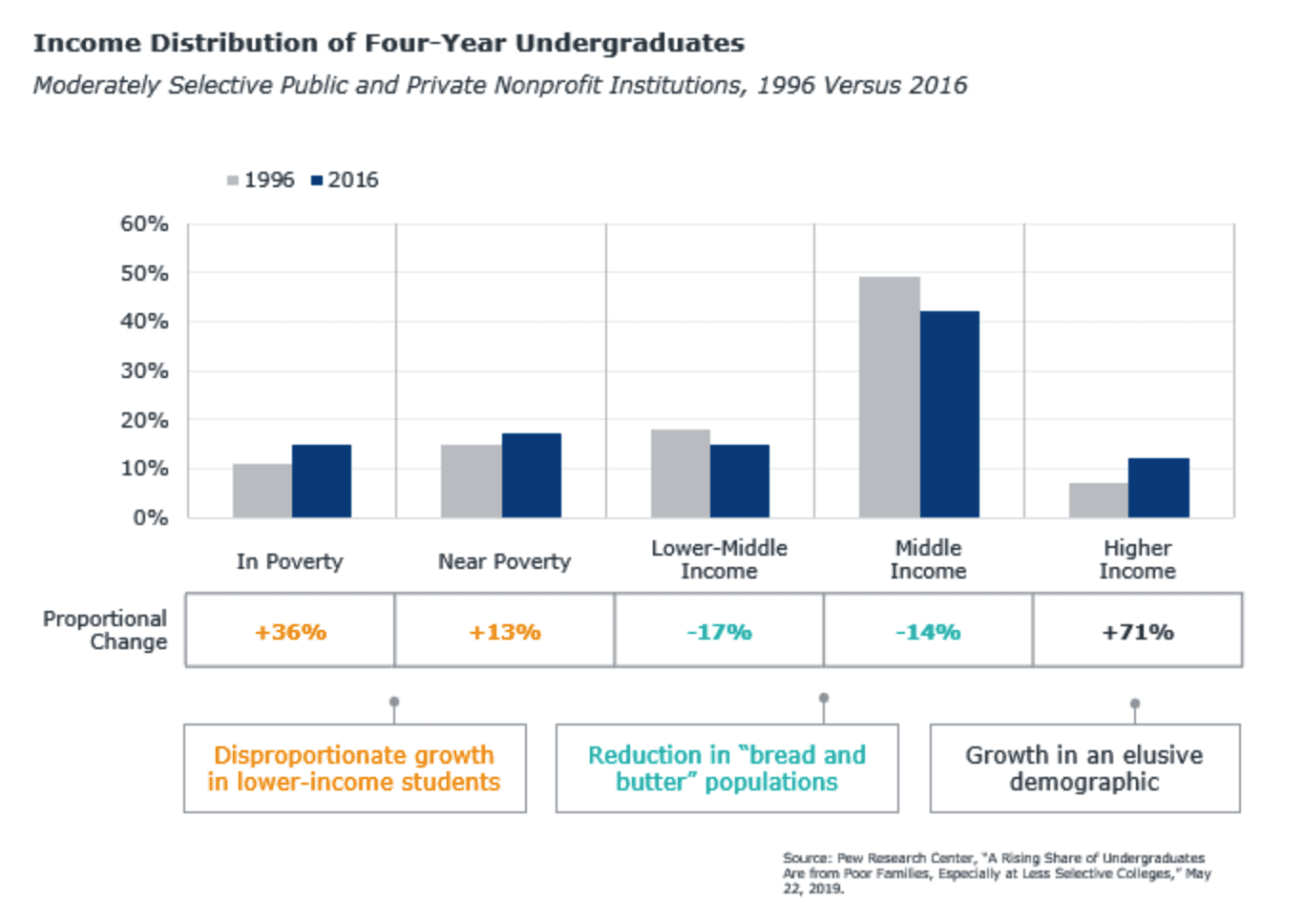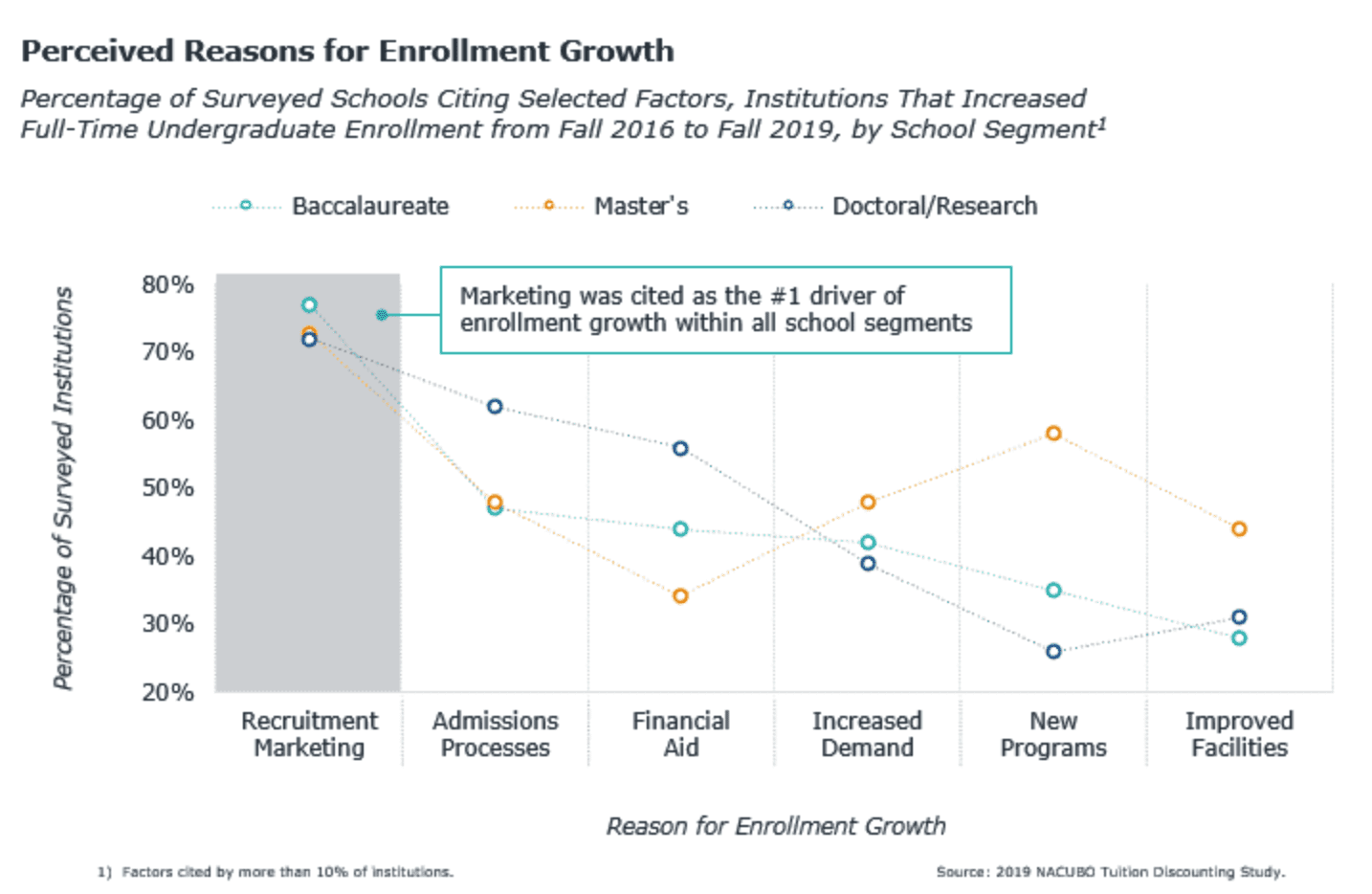9 ways recruitment marketing can help address families' growing college cost concerns
January 29, 2021
In recent months, a major preoccupation for my enrollment colleagues has been the financial impact of the COVID-19 pandemic on families. As a result, some students won’t be able to afford the schools they had hoped to attend (or any school at all).
This is a focus worthy of our concern. But it’s just the latest development in a much longer story of growing financial pressure on families. For years now, the proportion of college students living in or near poverty has been growing, while middle-income populations-the “bread and butter” of college enrollment-have been shrinking.
Learn about implications this trend has for enrollment leaders, specifically, how it has increased price sensitivity among college-bound students, what this means for your enrollment outcomes, and nine ways to address families’ growing concern over cost.

Enrollment outcomes at risk
Most enrollment leaders assume that financial pressures cause families to seek out cheaper college options, and the evidence bears this out. As college-going demographics have shifted to the lower end of the socioeconomic spectrum-a trend that has intensified across the past ten years-cost has played an increasingly important role in students’ choice of school. More recently, the pandemic has given us a vivid illustration of the sudden impact that financial pressures can have on college spend; EAB survey data shows that the maximum amount parents were willing to pay for college dropped significantly after COVID-19 took off in 2020.

The associated risk to colleges is not hypothetical; families’ growing preoccupation with cost has had a measurable negative impact on enrollment for many schools. For example, in recent NACUBO surveys, 73% of baccalaureate colleges that lost enrollment from fall 2016 to fall 2019 attributed the drop to price sensitivity.
-
73%
of baccalaureate colleges that lost enrollment from fall 2016 to fall 2019 attributed the drop to price sensitivity
Also contributing to the challenge is the fact that information on potential schools has never been easier to come by or more difficult for schools to control. For example, an online tool developed by Georgetown University’s Center on Education and the Workforce enables families to compare average first-year debt and earnings for students graduating in a particular major, by school. These comparisons often reveal striking disparities—for example, graduates from some schools earn twice as much as graduates from others, even though they are carrying the same amount of debt.

In other words, students and parents are more inclined and more able than ever to judge the value of the investment they might make in a degree from your institution.
The role of recruitment marketing
The daunting reality for colleges and universities is that ensuring a high-value offering for students is a complex and resource-intensive undertaking. Projects aimed at producing significant improvements in a school’s value proposition-the introduction of new academic programs, for example, or meaningful improvements in on-time graduation rate-unfold on timelines measured in years, rather than months. Many schools feel they can’t afford to wait that long and wonder what they can do to address families’ growing price sensitivity in the near term.
One important way to respond is through recruitment marketing. The importance of this critical element of the enrollment leader’s toolkit has been amply demonstrated. For example, NACUBO survey data shows that 77% of baccalaureate institutions that grew enrollment from 2016 to 2019 identified marketing as the main factor that allowed them to do so-more than any other factor, by a wide margin. Furthermore, while not easy, well-executed recruitment marketing does have the virtue of producing results rapidly. It is not unheard of for schools to see double-digit percentage growth in freshman enrollment within a year of revamping their approach.
-
77%
of baccalaureate institutions that grew enrollment from 2016 to 2019 identified marketing as the main factor that allowed them to do so

Get your value messaging right
While there’s a lot that falls under the heading of “recruitment marketing,” the aspects of it that most directly address price sensitivity have to do with value messaging-focusing on topics that are known to be most important to families and conveying related communications in ways that maximize their impact.
Marketing, in this context, can be thought of as a way of equipping families with the information they need to make better decisions. Many students who trade down to cheaper options do so based on misconceptions. For example, they may be unaware of funding sources that could make a school affordable, or they may underappreciate core aspects of a school’s value proposition, such as rates of on-time graduation. Especially challenging in this regard are aspects of a school that matter a lot to students but defy easy summary or quantification-“culture” or “fit,” for example.
There are, unquestionably, better and worse ways of managing value-oriented communications with prospective students, and getting it right will be increasingly important in the highly competitive recruitment markets of the near future. Our new white paper, “Why You’re Worth It,” offers an in-depth look at nine lessons enrollment leaders can apply to ensure that their messaging is on target and communicated in a way that moves the dial with increasingly price-sensitive families. A brief overview of the lessons covered in the report is presented below.
9 lessons on communicating your value proposition to price-sensitive families
Educate on cost
Provide families with information on college finances starting early in a student’s high school career, including explanations of key concepts such as sticker price versus net price.
Invest in promoting academic programs
Partner with your faculty to ensure that the academic program pages on your school’s website paint a compelling picture of the interesting, exciting, and rewarding things their students do.
Emphasize career connections
Underscore aspects of your offering that prepare students for today’s fast-changing job market and enable graduates to thrive in a variety of possible careers.
Activate your guarantees
If you offer an on-time graduation guarantee, ensure that students understand why it is of value, i.e., many students don’t finish on time, and schools play a key role in that.
Provide a virtual-visit experience worthy of your institution
Ensure that your virtual campus tour comes as close as possible to replicating the feeling of being there—an aim that is more attainable than ever thanks to recent advances in web media.
Connect cost and benefit messaging
Never show information about your cost of attendance (or other financial topics likely to make families anxious) without also providing compelling illustrations of the benefits of attending your school.
Hardwire high-touch engagement
Students see their recruitment experience as a preview of how they will be treated after enrolling; lavish, personalized attention sends them the message they most want to hear.
Leverage peer opinion
Take reasonable steps to influence the information that appears about you on channels where students seek peer opinions (including YouTube and Reddit).
Demonstrate differentiated value
Ensure that your outreach to prospective students, especially during yield season, is informed by a clear picture of who your main competitors are and ways in which you outperform them.
More Blogs

18 campus tour tweaks that win over students

Why brand management is your best bet for fighting higher ed’s image problem
